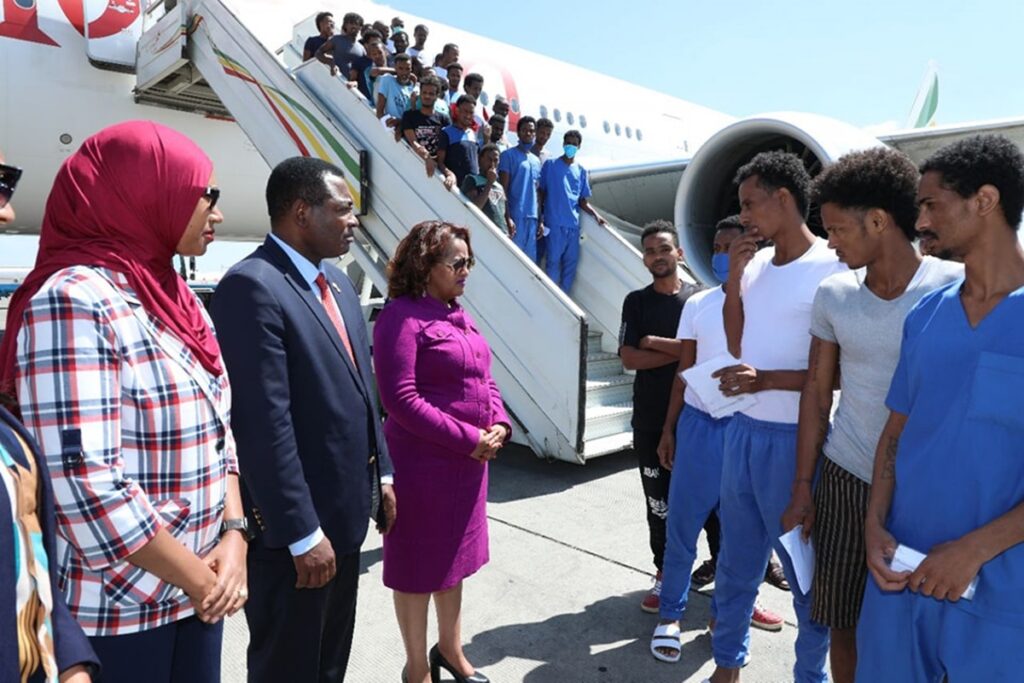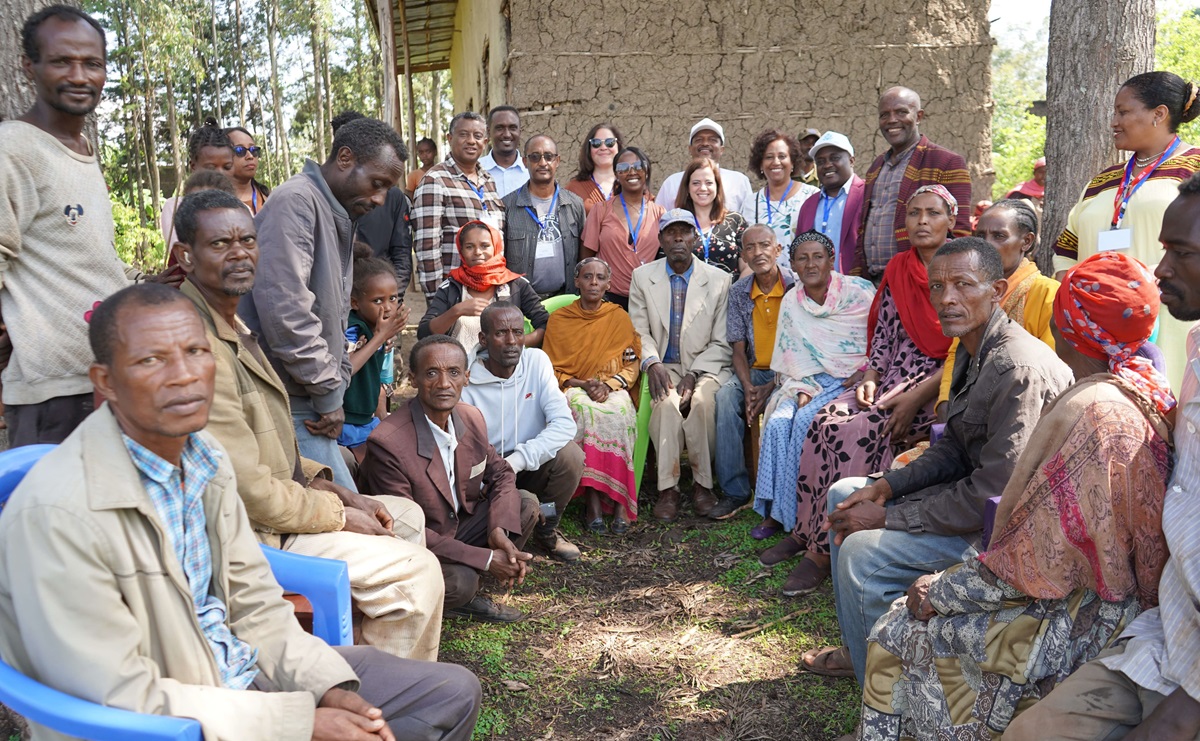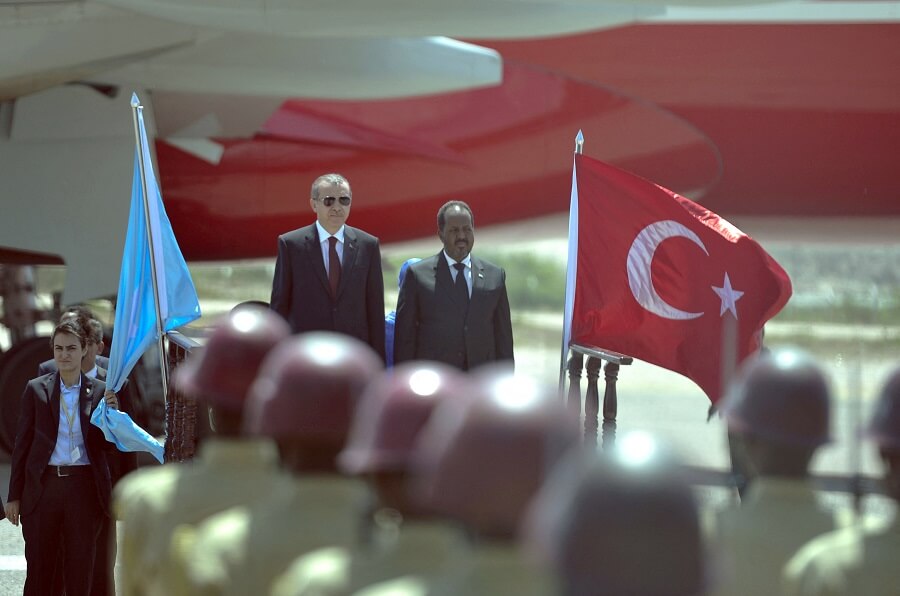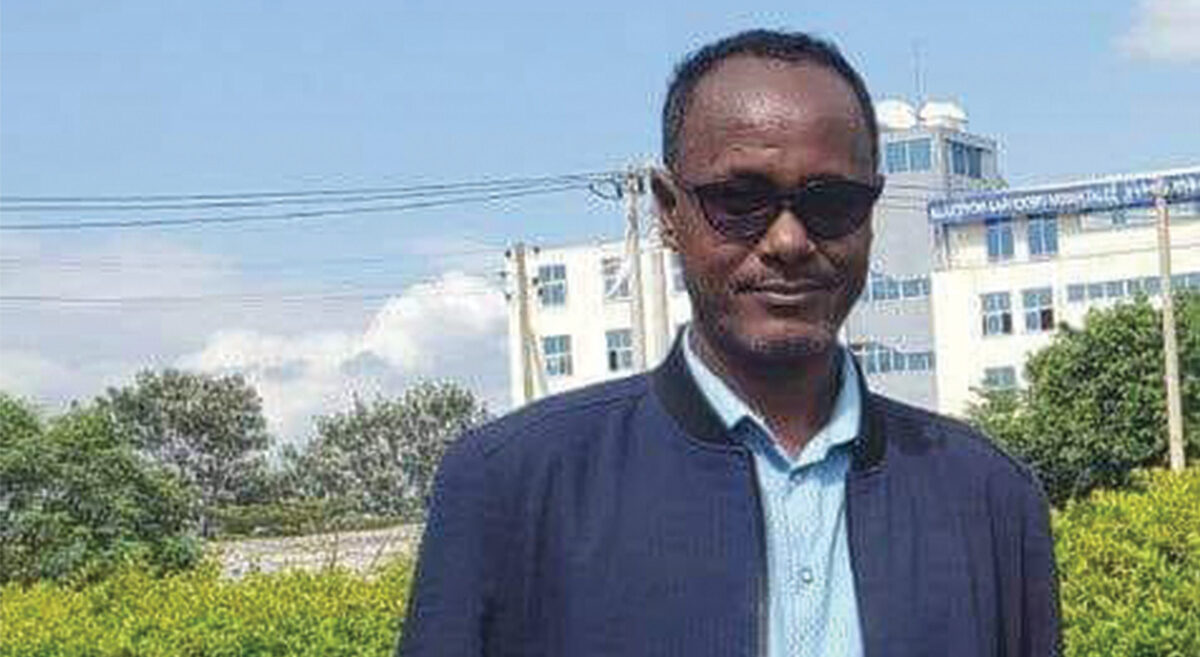In-depth: Trapped and Forgotten: Ethiopian migrants share plight from Saudi detention centers, yearning for swift response

By Mihret G/kristos @MercyG_kirstos
Addis Abeba – Belay Desta (name changed), an Ethiopian national, embarked on a daring passage to Saudi Arabia five years ago, guided by smugglers navigating the treacherous waters of the Red Sea and the war-torn landscapes of Yemen.
Little did he anticipate that his pursuit of opportunity by working as a driver would lead him into the unforgiving grip of Saudi Arabian authorities.
Within months of beginning his employment, Belay found himself ensnared in a web of suspicion, accused of illegal alcohol trafficking without a shred of legal recourse.
His punishment? a two-year sentence, delivered without the dignity of a proper trial.
“They put me in jail because I was suspected of alcohol trafficking,” recalls Belay.
Yet, even after serving his time, Belay’s odyssey was far from over.
[expander_maker id=”1″ more=”Click here to continue reading” less=”Read less”]Cast into the confines of Al-Shumaisi Detention Center, a desolate outpost on the fringes of Jeddah, he joined the ranks of deported Ethiopians awaiting repatriation, their dreams shackled by the harsh realities of irregular migration.
In his words, Belay echoes the anguish of countless migrants trapped in the labyrinthine corridors of Saudi Arabian detention.
He delineated the severe conditions prevailing in the Al-Shumaisi Detention Center, underscoring issues of hunger, disease, and an absence of medical treatment, which have unfortunately resulted in the deaths of fellow detainees.
“No individual can leave the Al-Shumaisi unless they are in serious health condition,” stated Belay.
However, he managed to send a recorded video to Addis Standard, offering a detailed account of the harsh conditions prevailing within the detention facility.
The video depicted a situation where up to 300 individuals are packed into a single room that was originally designed to accommodate only 64 occupants.
“The majority of detainees sleep on the floor without blankets, enduring sweltering temperatures without sufficient ventilation,” he explains. “The lack of medical attention exacerbates the challenges, with only a small fraction of detainees receiving treatment for various ailments.”
The Al-Shumaisi Detention Center is among the largest facilities of its kind in the Kingdom of Saudi Arabia. It was established to detain individuals who violate residency and labor regulations, serving as a holding facility for undocumented foreign workers before their repatriation to their respective countries.
Encompassing an expansive area of 2.5 million square meters along the Jeddah-Makkah Expressway, the center boasts a capacity to accommodate 32,000 inmates, according to official data.
However, Belay estimates that approximately 50,000 Ethiopian migrants are currently detained in Al-Shumaisi. He says the pressing need for intervention extends beyond addressing the immediate requirements of the detained migrants.
In an attempt to seek assistance, Belay and his fellow detainees endeavored to communicate with the Ethiopian Embassy in Saudi Arabia a year ago; however, their appeals remained unanswered.
He recounts that a hunger demonstration eventually compelled embassy officials to visit, providing assurances of an imminent repatriation flight within four months.
“Unfortunately, there has been no subsequent follow-up or communication from the embassy,” he laments.
Similar to Belay, a group of Ethiopian youths detained at Al-Shumaisi recently sent a recorded video to Addis Standard.
The video, recorded in three languages—Afaan Oromoo, Amharic, and Tigrigna—communicates that the individuals have completed sentences ranging from one to ten years, and the Saudi government has released them.
Despite their release from prison, they assert they remain stranded in Al-Shumaisi as no arrangements have been made for their repatriation. The group asserts to have waited for nine months without finding a solution, with the Ethiopian Embassy promising to send at least 20 individuals per flight, yet no progress has been evident.
The majority of detainees sleep on the floor without blankets, enduring sweltering temperatures without sufficient ventilation.”
An Ethiopian migrant held at Al-Shumaisi Detention Center
The detainees express their distress, citing the prevalence of transmitted diseases and the unfortunate deaths of at least three individuals in recent days. They urgently appeal for support to alleviate their current plight.
Human rights organizations have long criticized the conditions within these centers. In its 2022 report, Amnesty International disclosed that Saudi authorities are detaining Ethiopian migrants indefinitely in inhumane and cruel conditions solely because they lack valid residency documents.
The report details the situation of Ethiopian men, women, and children arbitrarily held in the overcrowded Al-Kharj and Al-Shumaisi detention centers, enduring dire and abusive conditions, and being forcibly returned to Ethiopia between June 2021 and May 2022.
Although human rights groups like Amnesty International have repeatedly called upon Saudi authorities to investigate cases of torture and deaths in custody, no results have been seen in this regard.
According to studies, Saudi Arabia currently hosts approximately 750,000 Ethiopian migrants, with around 60% (450,000) believed to have entered the country through irregular means.
Undocumented Ethiopian migrant workers in Middle Eastern countries like Saudi Arabia often find themselves unable to legalize their residency status. Consequently, they are compelled to wait at detention centers until arrangements are made for their repatriation to Ethiopia.
Based on a 2023 survey conducted by the Mixed Migration Center, 95% of surveyed Ethiopians reported being detained in Saudi Arabia due to their migration status before their return.
In the early 2010s, Saudi Arabia initiated stringent immigration policies aimed at foreign workers, leading to the deportation of approximately 170,000 Ethiopians in late 2013 and early 2014. Since 2017, however, Saudi Arabia has intensified its efforts to arrest and forcibly return Ethiopian migrants as part of a crackdown on undocumented migrant workers within its borders.
The most recent wave of repatriations saw 102,000 migrants deported by Saudi Arabia in 2022, mostly undocumented migrants.
Untangling the roots, consequences of irregular migration
An Ethiopian migrant currently working legally in Saudi Arabia shared his experiences with Addis Standard. He emphasizes that a significant number of Ethiopian citizens who have migrated face various challenges, including human rights violations, both while attempting to enter through Yemen and after their arrival in Saudi Arabia.
The migrant reveals that there is presently a troubling situation involving brokers exploiting youths who have crossed from Ethiopia to Yemen. These brokers are deceiving individuals by offering a reward to those who bring two or more people. “Consequently, a substantial number of individuals, particularly from the Tigray, Amhara, and Oromia regions, are migrating to the Middle East,” he disclosed.

According to the migrant, young men and women are being coerced to pay a minimum of 3,500 riyals.
“They kill people who don’t pay them,” he asserted. “Many women are being subjected to rape under these circumstances.”
He further revealed that many women arrive pregnant and face serious challenges as they are compelled to pay around 5000 riyals to give birth and receive medical treatment in Saudi Arabian hospitals. “They are enduring significant hardships with their newborn babies.”
Moreover, the migrant discloses that ex-combatants from Tigray are among those seeking refuge in Saudi Arabia and Yemen, despite bearing wounds and having metal implants in their bodies. “Furthermore, pregnant women are also part of the group fleeing from Ethiopia through unofficial channels.”
In November 2023, Addis Standard published an article revealing a rising trend: an increasing number of young people from the war-torn Tigray region are seeking alternative routes to reach the Arabian Peninsula.
These individuals embark on perilous journeys from the coast of Djibouti, crossing the treacherous Gulf of Aden, in search of better opportunities. However, this path has become increasingly hazardous, raising concerns for their safety.
In an interview with Addis Standard, Haysh Subagadis, the head of the Tigray Youth Affairs Bureau, expressed concern about the escalating number of Tigray youth engaging in informal migration to the Arabian Peninsula and other African countries via various routes. He states that authorities have received alarming reports regarding this issue.
Haysh emphasized the severity of the situation, noting that some parents have received death notifications and ransom demands exceeding one million birr from smugglers in Yemen and other transit countries.
He stated that while precise figures on the number of migrants from Tigray are unavailable, local administrators in the region have reported that over 3,000 young individuals have fled from a single district alone within a four-month period.
Negera Gudeta, a researcher on migration and security and a PhD candidate at the Institute of Peace and Security Studies, Addis Ababa University, contends that migration should not be perceived merely as a problem. Instead, he argues it should be regarded as an intrinsic human mobility phenomenon that has persisted since antiquity.
Nevertheless, Negera emphasizes that migration is a multifaceted and context-specific phenomenon, particularly evident within Ethiopia’s unique circumstances. This complexity arises from a confluence of various factors, including economic incentives, drought, climate change, and political instability.
“The success stories of migrants also play an integral role in influencing migration,” he elaborates.
Negera underscores that tragic political events such as the civil war in the Tigray region and ongoing armed insurgencies in the Oromia and Amhara regions, alongside associated security challenges, significantly contribute to migration trends, whether irregular or regular.
However, Negera stresses that a pivotal driving force behind migration remains the absence of viable economic opportunities.
“Ethiopia grapples with high unemployment rates, particularly among its youth,” he emphasizes. “The scarcity of quality employment and alternative sources of income can incentivize individuals to seek better economic prospects elsewhere.”
Krizia Kaye Viray, the Media and Communications Officer at IOM Ethiopia, argues the absence of sustainable livelihood opportunities in migrants’ home communities significantly heightens the likelihood of embarking on perilous irregular migration routes.
Viray emphasizes that the IOM is working to tackle the causes of migration by offering individual and community-based livelihood assistance programs. The objective is to alleviate the economic hardships that often compel individuals to engage in irregular migration.
Moreover, Viray highlights that the IOM is engaged in the dissemination of accurate information regarding the hazards associated with irregular migration and the availability of lawful migration channels.
“Human smugglers and traffickers entice migrants with deceptive assurances of inexpensive, rapid, and secure journeys, and the IOM collaborates with communities and local authorities to provide a pragmatic counter-narrative,” she remarked.
Negera emphasizes the need for public and private partnerships to tackle the challenges of illegal migration in Ethiopia.
The absence of sustainable livelihood opportunities in migrants’ home communities significantly heightens the likelihood of embarking on perilous irregular migration routes.”
Krizia Kaye Viray, Media and Communications Officer at IOM Ethiopia
He suggests that investing in programs for economic development, such as modernizing agriculture, improving infrastructure, and promoting entrepreneurship, can elevate living standards and expand job opportunities.
“This approach can diminish the incentives for migration by offering people viable domestic employment options,” he argues.
Repatriation efforts amidst challenges
According to an official from the Ethiopian Ministry of Foreign Affairs, who spoke on condition of anonymity due to media restrictions, the government has undertaken significant efforts over the past eighteen months to repatriate its citizens who migrated irregularly and were deported, particularly from Gulf nations and South Africa.
The official stated that, through collaborative efforts between the Ethiopian and Saudi Arabian governments, at least 130,000 migrants detained in various centers over the past nine months have been repatriated to Ethiopia.
Additionally, amidst political unrest in Yemen, the Ethiopian government has been actively repatriating citizens from cities like Sanaa and Aden, as well as from African countries such as Kenya, Tanzania, Zambia, and Malawi.
According to the official, this process involves collaboration with international organizations, including the IOM.
Furthermore, the official emphasized that these repatriated individuals, who endured distressing conditions, received treatment upon arrival to facilitate their reintegration into society.
However, Viray from IOM Ethiopia emphasizes the significance of acknowledging the limited resources allocated for providing post-arrival support by the government, IOM, and other responders. “This reality, coupled with the substantial volume of returns, inevitably leads to occasional challenges in service delivery.”
Viray disclosed that the International Organization for Migration (IOM) has repatriated nearly 20,000 migrants since 2020 under its Voluntary Humanitarian Return (VHR) initiative. The largest contingent of migrants returned from Yemen, with Djibouti and countries along the Southern Route, such as Tanzania, also featuring prominently.
Additionally, the IOM has provided assistance to Ethiopians returning from various locations worldwide, including distant destinations like Venezuela and Myanmar.
However, Viray clarified that the IOM does not facilitate the repatriation of migrants from Saudi Arabia. The significant return movements observed since 2017 stem from bilateral agreements and arrangements between the governments of Ethiopia and Saudi Arabia, with no involvement from the IOM.
According to the IOM, a total of 254,263 migrants have been repatriated from Saudi Arabia since 2020, in accordance with the agreement between the two governments.
“IOM’s involvement in assisting returnees from Saudi Arabia begins only after migrants arrive at Addis Ababa Bole International Airport,” she explained. AS [/expander_maker]
Become a patron and support Addis Standard’s independent journalism!
As we continue our mission to deliver quality journalism that informs and engages our audience at this time when doing so comes with great sacrifices, we are seeking voluntary support from discerning patrons like yourself who share our commitment to journalistic integrity and the pursuit of truth, and want to appreciate the hard work our team is doing to deliver timely, impartial and impactful stories.
No matter the amount, your patronage can make a significant difference in sustaining our operations and ensuring the continued production of insightful and independent content.
We remain humbled and feel appreciated by every amount we receive from you, our reader!







